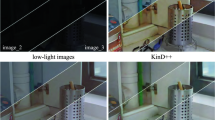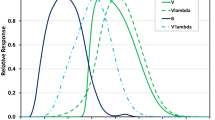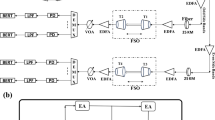Abstract
In this paper, various aspects of a color-space-based visible-light communication (VLC) system design are explored, including feasible light color spaces, potential constellation diagrams, data-to-light intensity mapping, and light intensity-to-data demapping. After describing the proposed VLC system and parameters essential for a color-space-based VLC system design, numerous methods of constellation design for generating a target color in a light color space are presented. The proposed method also incorporates a technique to calculate light intensity from the constellation point. The performance of a proposed system is analyzed with an additive white Gaussian noise channel along with various color scenarios. We also investigate two cases to obtain the target color information at the receiver. Simulation results are presented in order to evaluate the performance of the proposed VLC system.











Similar content being viewed by others
References
Komine, T., & Nakagawa, M. (2004). Fundamental analysis for visible-light communication system using LED lights. IEEE Transaction of Consumer Electronics, 50, 100–107.
Grubor, J., Gaete, J.-O., Waleski, J., & Randel, S. (2007). High-speed wireless indoor communication via visible light. ITG Fachbericht, 198, 203–208.
Nguyen, H. Q., Choi, J.-H., Kang, M., Ghassemlooy, Z., Kim, D. H., Lim, S.-K., et al. (2010). A MATLAB-based simulation program for indoor visible light communication system. In 7th International Symposium on Communication Systems Networks and Digital Signal Processing (CSNDSP) (pp. 100–107).
Vucic, J., Kottke, C., Nerreter, S., Langer, K.-D., & Walewski, J. W. (2010). 513 Mbit/s visible light communications link based on DMT-modulation of a white LED. Journal of Lightwave Technology, 28(2), 3512–3518.
Minh, H. L., O’Brien, D., Faulkner, G., Zeng, L., Lee, K., Jung, D., et al. (2008). High speed visible light communications using multiple-resonant equalization. IEEE Photonics Technology Letters, 1(2), 1243–1245.
Rahaman, M. S., Haque, M. M., & Kim, K.-D. (2011). Indoor positioning by LED visible light communication and image sensors. Internatioal Journal of Electrical and Computer Engineering, 9(4), 161–170.
Yoshino, M., Haruyama, S., & Nakagawa, M. (2008). High-accuracy positioning system using visible LED lights and image sensor. In IEEE Radio and Wireless Symposium (pp. 439–442).
Lee, K., & Park, H. (2011). Modulations for visible light communications with dimming control. IEEE Photonics Technology Letters, 23(16), 1136–1138.
Anand, J. M., & Mishra, P. (2010). A novel modulation scheme for visible light communication. In 2010 Annual IEEE India Conference (INDICON) (pp. 1–3).
Park, H., & Barry, J. R. (1995). Modulation analysis for wireless infrared communications. IEEE International Conference on Communication, 2, 1182–1186.
Hashemi, S. K., Ghassemlooy, Z., Chao, L., & Benhaddou, D. (2008). Orthogonal frequency division multiplexing for indoor optical wireless communications using visible light LEDs. In 6th Internatioal Symposium on Communication Systems Networks and Digital Signal Processing (CSNDSP) (pp. 174–178).
Afgani, M. Z., Haas, H., Elgala, H., & Knipp, D. (2006). Visible light communication using OFDM. In Proceedings IEEE Symposium on Wireless Pervasive Computing.
Sugiyama, H., Haruyama, S., & Nakagawa, M. (2006). Experimental investigation of modulation method for visible-light communication. IEICE Transaction of Communication, E89–B(12), 3393–3400.
IEEE Standard for local and metropolitan area networks Part 15.7: Short-range wireless optical communication using visible light. In IEEE Standard 802.15.7 (2011).
Yokoi, A. (2008). (Samsung Yokoham Research Institute), Color multiplex coding for VLC. In IEEE P802.15 Working Group for Wireless Personal, Area Networks (WPANs).
Drost, R. J. & Sadler, B. M. (2010). Constellation design for color-shift keying using billiards algorithms. In 2010 IEEE GLOBECOM Workshops (GC Wkshps) (pp. 980–984).
Das, P., Kim, B.-Y., Park, Y., & Kim, K.-D. (2013). Color independent VLC based on a color space without sending target color information. Optics Communications, 286, 69–73.
Chang, S.-Y. (2009). The characteristics analysis of VLC technologies. Korea Information and Communication Society (Information and Communication Magazine), 26(5), 15–22.
Berns, R. S. (2000). Principles of color technology, chapter 2. New York: Wiley.
Rahaman, M. S., Kim, B.-Y., Bang, M.-S., Park, Y., & Kim, K.-D. (2009). Color space mapping and medium access control techniques in visible light communication. The Institute of Webcasting, Internet Television and Telecommunication, 9(4), 99–107.
Ries, H., Leike, I., & Muschaweck, J. (2004). Optimized additive mixing of colored light-emitting diode sources. Optical Engineering, 43, 1531–1356.
Nassau, K., et al. (1996). Color for science, art and technology. Amsterdam: Elsevier.
Barry, J. R., Lee, E. A., & Messerschmitt, D. G. (2004). Digital communication. Norwell, MA: Kluwer.
Kahn, J. M., & Barry, J. R. (1997). Wireless infrared communications. Proceedings of IEEE, 85, 265–298.
Tanaka, Y., Komine, T., Haruyama, S., & Nakagaa, M. (2003). Indoor visible light data transmission system utilizing white LED lights. IEICE Transaction on Communication, E86B(8), 2440–2454.
O’Brien, D., Minh, H. L., Zeng, L., Faulkner, G., Lee, K., & Jung, D., et al. (2008). Indoor visible light communications: Challenges and prospects. In Proceedings of SPIE (Vol. 7091, pp. 1–9).
Acknowledgments
This work was supported by the MSIP (Ministry of Science, ICT & Future Planning), Korea in the ICT R&D Program 2013 as well as by the Global Scholarship Program for Foreign Graduate Students at Kookmin University in Korea. The authors are also grateful to Dr. Soo-Young Chang for helpful discussions.
Author information
Authors and Affiliations
Corresponding author
Rights and permissions
About this article
Cite this article
Das, P., Park, Y. & Kim, KD. Performance Analysis of Color-Independent Visible Light Communication Using a Color-Space-Based Constellation Diagram and Modulation Scheme. Wireless Pers Commun 74, 665–682 (2014). https://doi.org/10.1007/s11277-013-1312-8
Published:
Issue Date:
DOI: https://doi.org/10.1007/s11277-013-1312-8




